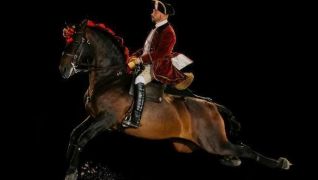
19 Aug 2015
Traditional Portuguese Equestrian Art returns to Belém
In July, the Portuguese School of Equestrian Art (EPAE), under the management of Parques de Sintra – Monte da Lua, began a programme of regular performances and training sessions open to the general public at the Henrique Calado Riding Hall, located on Calçada da Ajuda, in Belém.
At this central location, the public has the opportunity to attend not only training sessions but also weekly performances and galas. At the training sessions, visitors can watch the work that gets carried out daily by the riders, whilst the performances feature a diverse range of choreographies and exercises, such as the carousel, long reining and airs above the ground to the sound of specifically selected music. In the galas, held to commemorate special dates and occasions, the shows are more extensive and include a variety of performances accompanied by lighting and sound effects to bring added splendour to the scenario.
EPAE, one of Europe’s four classical dressage schools, was set up in 1979 with the specific objective of teaching, performing and raising the profile of traditional Portuguese Equestrian Art and in keeping with the legacy handed down by the Real Picaria (Royal Stables), the equestrian academy of the Portuguese court, which was closed down in the 19th century. After a time at the Sociedade Hípica Portuguesa (Portuguese Riding Company) in Campo Grande, the Portuguese School of Equestrian Art moved to new premises in the National Palace of Queluz in 1996, where it staged regular presentations open to the public.
A visit to the Henrique Calado Riding Hall provides an opportunity to travel back through Portuguese history, experiencing the moments that perpetuated the beauty of the Lusitano horses from the Alter Real Stud Farm. This breed has been used in classical dressage since the 18th century, performing classical dressage exercises alongside those from the Baroque period and the exercises making up the Court Games (tournaments held between the 16th and 19th centuries to commemorate festive occasions). The experience is further enriched by the costumes, saddles and harnesses worn by riders and horses, whether the normal working versions used for daily training, or the gala versions worn for weekly presentations and gala performances, since they are identical to those in use in the earliest days of Portuguese Equestrian Art.
More information in www.arteequestre.pt




 Explore
Explore 
 Remember and Share
Remember and Share 


